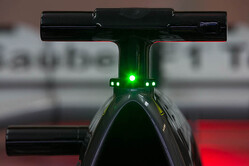 There has been a certain amount of schadenfreude over the problems faced by the F1 teams using Renault engines. Red Bull seems to have been particularly affected which, for some, comes as a relief after the team's recent dominant performance.
There has been a certain amount of schadenfreude over the problems faced by the F1 teams using Renault engines. Red Bull seems to have been particularly affected which, for some, comes as a relief after the team's recent dominant performance.
If it is any comfort to Red Bull, at least their cars proceeded under their own power. When the first McLaren-TAG went to test in 1983, it would not start at all. That is a price you can sometimes pay when dealing with new technology.
When Toleman decided to enter Formula One, the team fitted a turbocharged Hart engine to a Formula Two Toleman (which used a normally aspirated Hart engine) and Brian Henton pounded around Goodwood. Brian was not aiming for a time, he was running with F2 tyres and brakes, the exercise was a systems test, to make sure that everything worked as it should. This has been denied teams this year by the FIA's restriction on testing.
We not only have new engines, with turbochargers, but we have a larger KERS system plus bigger batteries. There has never been a more radical set of changes in the history of Formula One. You might have thought that in the light of this, the FIA could have been flexible over testing even if only for a few weeks.
To ensure that the exercise was systems testing and to prevent anyone earning a performance advantage, it would have been possible to impose a handicap. Pirelli could have run up some rock hard tyres, or engines could have had a rev restriction.
We do not want the main focus of interest on the Australian GP to see which cars can complete even qualifying, let alone last a whole race. Apart from anything else, there is the safety issue. Cars should line up on a grid having been thoroughly tested.
In the recent past there have been incremental changes to cars year on year. McLaren took a wrong turn last year, but we are talking in time per corner that has no meaning in everyday life. A tenth is huge in F1 terms, but nobody could start and stop a stop watch in less than two tenths.
McLaren took a wrong turn in detail, but all the main working features were carried over from 2012 and, before that, from 2011. For most teams, change is gradual. The modifications which are made throughout a season are mainly aerodynamic, teams no longer ditch an entire design as Arrows did with the A2 or Lotus with the T80.
Teams need data and, before a season starts, that can only come from testing. There are issues like fuel consumption and tyre wear, and fuel will play a bigger part in 2014 than at any time since the mid-1980s when turbo boost and fuel consumption were both reined in.
Formula One wants to put on a show, hence double points for the last race. It is not going to be much of a show if a race turns into an economy run.
Before each race already we have TV pundits informing us about tyre wear, DRS zones, use of KERS, and loads of other stuff which might enthral a 12 year-old game player, but which does nothing for me. I cannot be alone in feeling that, this year, I ought to listen to the talking heads and take notes if I am to follow the action. That is not my idea of putting on a show.
A reader, Graham Warley, has raised concerns about physical safety, concerns I share. Since the Lotus 49 of 1967, an F1 car has been a tube with a hole in it for the driver, a fuel tank and then the engine and gearbox bolted on to make a continuous unit. Regardless of materials and aerodynamic, that has been the recipe.
The rear end of a 2014 car carries much more stuff in the form of a larger electric motor and all the plumbing associated with turbochargers, Graham and I wonder whether there has been proper tasting of a rear-end shunt, bearing in mind that the configuration of the new cars is now radically different.
Gian Carlo Minardi has raised concerns about safety and when such a man speaks, I listen. Minardi has raised the basic issue of marshal training and what can, and what should not be touched, if a car has to be retrieved. There is a heap of electrical kit that has not been there before.
Since the 2014 cars are hybrids, they have to carry batteries and the logical place to locate them is beneath the (smaller) fuel tanks. Surely I cannot be the only person to have registered that Boeing's new Dreamliner has had problems with batteries.
The breadth and depth of Boeing's expertise is immense, many times greater than the whole of Formula One. Boeing has had unlimited testing and yet can still encounter glitches.
We like to think of Formula One as somehow being the ultimate in technology, but it is not, and never has been. Aviation has always been years ahead.






















sign in